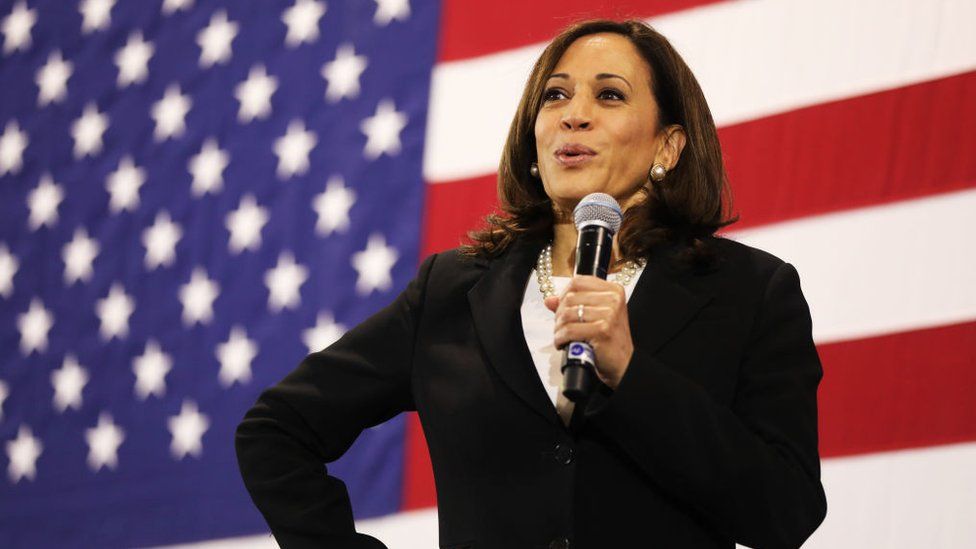
For two decades in public life, Kamala Harris has achieved a lot of firsts: the first Black woman to serve as San Francisco’s district attorney, the first woman to be California’s attorney general, first Indian American senator, and now, the first Black woman and first Asian American to be picked as a vice presidential running mate on a major-party ticket.
Presumptive Democratic nominee Joe Biden named Harris, his former rival, for the nomination to the number two spot this month, and she will now be working by his side towards unseating President Donald Trump this November.
But what more do we know about the 55-year-old prosecutor-turned-senator whose motto comes from her mom: “You may be the first, but make sure you’re not the last.” The daughter of immigrants, Harris was born in Oakland, California on October 20, 1964, to Shyamala Gopalan, a cancer researcher from India, and Donald Harris, an economist from Jamaica. Her parents met at UC Berkley while pursuing graduate degrees and the two were active in the civil rights movement right from their days on campus. When Kamala was born, they often took her along to protests in a stroller.
The eldest of two children, Harris grew up embracing both her Black and South Asian identities, and one time visited India while young, where it is documented that she “was heavily influenced by her grandfather, a high-ranking government official who fought for Indian independence, and grandmother, an activist who traveled the countryside teaching impoverished women about birth control.”Attending middle school and high school in Montreal, Kamala studied political science and economics (B.A., 1986) at Howard University, and then earned a law degree in 1989 from Hastings College. She subsequently worked as a deputy district attorney from 1990–98 in Oakland, prosecuting cases of drug trafficking, gang violence, and sexual abuse. Despite her parents not being too comfortable with her career choice, Kamala said she wanted to change the system from the inside, and with that determination, she moved up the ladder, becoming a district attorney in 2004. At the time, she had made a name for herself in San Francisco, not only through her work as a prosecutor but also through her friendships with the city’s elite and her relationship with former mayor Willie B.
They would support her with funding when she campaigned for office to become a district attorney in 2004. That same year, she made what has been described as one of her most controversial decisions; Kamala refused to pursue the death penalty against the man who killed San Francisco police officer Isaac Espinoza. She was heavily criticized for that. And when she ran for California attorney general, many thought she would lose to Steve Cooley, a popular white Republican who served as Los Angeles’ DA. Why? Kamala was a woman of color from liberal San Francisco who opposed the death penalty, but she made it, winning by a margin of less than 1 percent, thus becoming the first woman to hold the post in 2010. Even though she was criticized during her time as attorney general for not doing enough to cater to police brutality, especially when she refused to investigate the police shootings of two Black men in 2014 and 2015, she did demonstrate political independence while in office. She clashed with the Obama administration when California was offered $4 billion in a national mortgage settlement over the foreclosure crisis.
Fighting for a larger amount, Harris did not sign the deal, and at the end of the day, she was able to secure $20 billion for California homeowners, according to reports. Getting elected to the U.S. Senate in 2016 also raised her national profile as she went viral for her sharp interrogations of officials and nominees of the Trump administration, including then-Attorney General Jeff Sessions on the Russia investigation during a Senate Intelligence Committee hearing and Brett M. Kavanaugh during his Supreme Court confirmation hearing. But her most viral moment occurred during her 2020 presidential campaign. During the first Democratic debate, Harris criticized Biden for his position on a federal busing program in the 1970s that benefited minorities, including herself.
Biden looked shocked when Harris told him on the debate stage last July: “There was a little girl in California who was part of the second class to integrate her public schools. And she was bused to school every day,” she said. “And that little girl was me.” Though Harris’s support increased after that moment, by September 2019 she began falling behind in polling. Her campaign struggled due to internal staff rows and in December, she dropped out of the race. She, however, continued to have a well-publicized presence, particularly becoming a leading advocate for social justice reform in response to the killing of George Floyd. Her stance silenced critics who had slammed her while she was attorney general over claims she refused to investigate charges of police misconduct though she explained that she was only committed to a fairer criminal justice system. And amid the protests against police brutality and racial injustice in the United States, it’s not surprising that many prominent Black male leaders called on Biden to select a Black woman as his vice presidential running mate to increase his election chances. In August, Biden picked Harris, and if elected in November, the trailblazing prosecutor will become the first woman and first black vice president in the history of the United States.